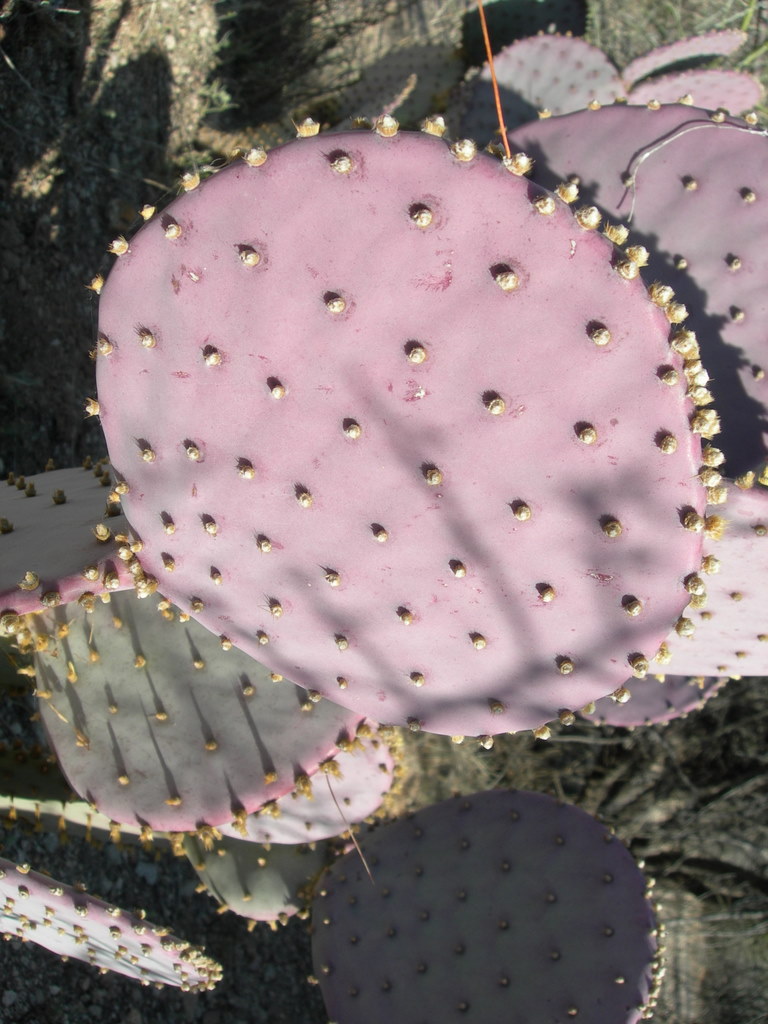Opuntia
|
Family: Cactaceae |
Trees or shrubs, erect to trailing, usually many branched, sometimes forming clumps or mats; trunk, when present, initially segmented, appearing continuous with age, main axis determinate, usually terete. Stem segments green or sometimes reddish to purple, usually flattened, circular, elliptic, ovate, lanceolate, or obovate to oblanceolate, 2-60(-120) × 1.2-40 cm, nearly smooth to tuberculate, glabrous or pubescent; areoles usually elliptic, circular, or obovate, 3-8(-10) × 1-7(-10) mm; wool white, gray, or tan to brown, aging white or gray to black. Spines 0-15+ per areole, white, yellow to brown, red-brown to gray, or black, sometimes partly to wholly white chalky (chalkiness disappearing when wet), aging gray to dark brown to black, with epidermis intact, not sheathed, acicular to subulate, sometimes setose or with hairlike bristles, terete to angular-flattened, to 75(-170) mm, tips sometimes paler or yellow. Glochids in adaxial crescent at margin of areole, in tuft or encircling areole margin, white to yellow to brown, or red-brown, aging white to brown or red-brown. Flowers bisexual or sometimes functionally staminate, radially symmetric; outer tepals green to yellow with margins tinged color of inner tepals; inner tepals pale yellow to orange, pink to red or magenta, rarely white (unicolored) or with base of a different color (bicolored), oblong to spatulate, emarginate-apiculate; nectar chamber simple, open, not covered by proximal thickening style. Pollen yellow, grains reticulate or foveolate (opuntioid type). Fruits sometimes proliferating (sprouting from another fruit), if fleshy, green, yellow, or red to purple or, if dry, tan to gray, straight, sometimes stipitate, clavate to cylindric, ovoid, or obovoid to subspheric, 10-120 × 8-120 mm, fleshy to juicy or dry, smooth or tuberculate, spineless or spiny, sometimes burlike. Seeds pale yellow to tan or gray, generally circular to reniform, flattened (discoid) to subspheric, angular to squarish, sometimes warped, 2-7 × 2-7 mm, glabrous, commonly bearing 1-4 large, shallow depressions due to pressures from adjacent developing seeds; girdle protruding 0.3-3.5 mm, forming ridge or flat wing, or not protruding. x = 11. Many taxa are cultivated for ornamental plants, food, and animal fodder. Some species of Opuntia become obnoxious weeds; some species have been planted in Africa for stabilization of sand dunes. Three species have been reported (L. D. Benson 1982) as escaped from cultivation: Opuntia leucotricha de Candolle, O. tomentosa Salm-Dyck, and O. monacantha (Willdenow) Haworth (as O. vulgaris). No extant populations are known in the flora. Many interspecific hybrids are known and have been named; only five are fully treated here; two other named hybrids recognized by the author are briefly described and cross-referenced under putative parent taxa.
PLANT: Trees or shrubs, erect, decumbent to trailing, much branched, the branches segmented. STEM SEGMENTS: (pads), of varied lengths and widths, strongly flattened or, in a few species, subcylindric to subspheric, bearing small, ephemeral, fleshy, conic, leaves. AREOLES bearing glochids and a dense wool. SPINES: with epidermis intact, not sheathing; major spines flattened to cylindric. FLOWERS: borne singly in areole; inner tepals pale yellow to orange, pink to red or magenta, rarely white, OR with bases of a different color, oblong to spatulate, emarginate-apiculate; outer tepals green to yellow with margins tinged color of inner tepals; stamens thigmotropic. POLLEN GRAINS: with reticulate ornamentation. FRUITS: fleshy to juicy (bleeding) and green, yellow or red to purple or dry and tan to gray, clavate to cylindric to subspheric, spineless or spiny, bearing on top an umbilicus (a large, usually depressed scar left from abscised flower parts). SEEDS: glabrous, pale yellow to tan to gray, 3-10 mm long, generally circular to reniform, flattened (discoid) to subspheric, angular to squarish, sometimes warped, commonly bearing 1-4 large, shallow depressions due to pressures from adjacent developing seeds, the girdle (midvein of funiculus which envelopes seed) smooth to protruding, ridged to strongly winged. NOTES: About 180 species (14 in the flora); Canada to southern Argentina, West Indies, Galápagos Islands. Many introduced to the Old World; many cultivated. (Origin of “opuntia” uncertain; presumably based on name of Greek town, Opus, perhaps, where a cactus-like plant grew). REFERENCES: Pinkava, Donald J. Cactaceae. 2003. J. Ariz. - Nev. Acad. Sci. Volume 35(2). Stems branched and jointed, the joints cylindric to flattened; spines and glochids arising from the areoles, or the plants virtually spineless; fls borne within the areoles near the tips of joints of the previous year; pet and sep rotate from the summit of the scarcely prolonged hypanthium; stamens shorter than the pet; seeds wingless. 150+, New World. Gleason, Henry A. & Cronquist, Arthur J. 1991. Manual of vascular plants of northeastern United States and adjacent Canada. lxxv + 910 pp. ©The New York Botanical Garden. All rights reserved. Used by permission. |

